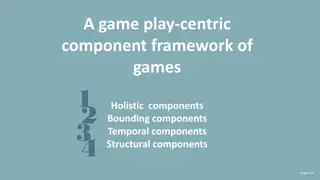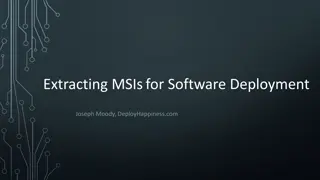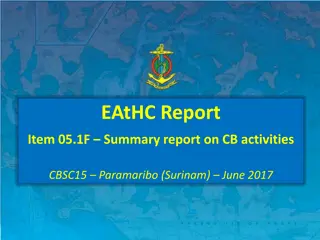
Understanding MSI Components in Integrated Circuits
Explore the world of Medium-Scale Integration (MSI) components in integrated circuits through Aaron Tan's NUS Lecture #18. Learn about decoders, encoders, demultiplexers, and multiplexers, and delve into the efficiency of decoding methods. Discover how codes can represent entities and how decoders can decode these codes efficiently.
Uploaded on | 0 Views
Download Presentation

Please find below an Image/Link to download the presentation.
The content on the website is provided AS IS for your information and personal use only. It may not be sold, licensed, or shared on other websites without obtaining consent from the author. If you encounter any issues during the download, it is possible that the publisher has removed the file from their server.
You are allowed to download the files provided on this website for personal or commercial use, subject to the condition that they are used lawfully. All files are the property of their respective owners.
The content on the website is provided AS IS for your information and personal use only. It may not be sold, licensed, or shared on other websites without obtaining consent from the author.
E N D
Presentation Transcript
http://www.comp.nus.edu.sg/~cs2100/ Lecture #18 MSI Components
Questions? Ask at https://sets.netlify.app/module/676ca3a07d7f5ffc1741dc65 OR Scan and ask your questions here! (May be obscured in some slides)
Aaron Tan, NUS Lecture #18: MSI Components 3 Lecture #18: MSI Components 1. Introduction 2. Decoders 3. Encoders 4. Demultiplexers 5. Multiplexers
Aaron Tan, NUS Lecture #18: MSI Components 4 1. Introduction (1/2) An integrated circuit (referred to as an IC, a chip or a microchip) is a set of electronic circuits on one small flat piece (or chip ) of semiconductor material. Scale of integration: the number of components fitted into a standard size IC Name Signification Year #transistors #logic gates SSI Small-scale integration 1964 1 to 10 1 to 12 MSI Medium-scale integration 1968 10 to 500 13 to 99 LSI Large-scale integration 1971 500 to 20000 100 to 9999 VLSI Very large-scale integration 1980 20k to 1m 10k to 99999 ULSI Ultra-large-scale integration 1984 1m and more 100k and more
Aaron Tan, NUS Lecture #18: MSI Components 5 1. Introduction (2/2) Four common and useful MSI circuits: Decoder Demultiplexer Encoder Multiplexer Block diagrams of the above MSI circuits: decoder encoder code entity entity code mux output data demux data input select select
Aaron Tan, NUS Lecture #18: MSI Components 6 2. Decoders (1/5) Codes are frequently used to represent entities, eg: your name is a code to denote yourself (an entity!) These codes can be identified (or decoded) using a decoder. Given a code, identify the entity. Convert binary information from n input lines to (a maximum of) 2n output lines. Known as n-to-m-line decoder, or simply n:m or n m decoder (m 2n). May be used to generate 2n minterms of n input variables.
CS2100 Notes 7 Decoding the inefficient way 0 0 0 0 0 1 0 0 0 1 2 3 4 5 6 7
CS2100 Notes 8 Decoding the better way 1 0 1 Some device 0 1 2 3 4 5 6 7
Aaron Tan, NUS Lecture #18: MSI Components 9 2. Decoders (2/5) Example: If codes 00, 01, 10, 11 are used to identify four light bulbs, we may use a 2-bit decoder. 2x4 DEC F0 F1 F2 F3 Bulb 0 Bulb 1 Bulb 2 Bulb 3 X 2-bit code Y This is a 2 4 decoder which selects an output line based on the 2-bit code supplied. Truth table: X Y F0 0 0 1 0 1 0 1 0 0 1 1 0 F1 0 1 0 0 F2 0 0 1 0 F3 0 0 0 1
Aaron Tan, NUS Lecture #18: MSI Components 10 2. Decoders (3/5) X Y F0 1 F1 0 1 F2 0 F3 0 0 0 From truth table, circuit for 2 4 decoder is: 0 1 0 0 1 0 1 0 0 0 0 1 1 1 0 0 0 Note: Each output is a minterm (X' Y', X' Y, X Y' or X Y) of a 2- variable function F0 = X' Y' F1 = X' Y F2 = X Y' F3 = X Y X Y
Aaron Tan, NUS Lecture #18: MSI Components 11 2. Decoders (4/5) Design a 3 8 decoder. F0 = x' y' z' x y z F0 1 F1 0 1 F2 0 F3 0 F4 0 F5 0 F6 0 F7 0 F1 = x' y' z 0 0 0 F2 = x' y z' 0 0 1 0 0 1 0 0 0 0 0 F3 = x' y z 0 1 0 0 0 0 1 0 0 0 0 0 1 1 0 0 0 0 1 0 0 0 F4 = x y' z' 1 0 0 0 0 0 0 0 1 0 0 F5 = x y' z 1 0 1 0 0 0 0 0 0 1 0 F6 = x y z' 1 1 0 0 0 0 0 0 0 0 1 1 1 1 0 0 0 0 0 0 0 F7 = x y z x y z
Aaron Tan, NUS Lecture #18: MSI Components 12 2. Decoders (5/5) In general, for an n-bit code, a decoder could select up to 2n lines: n to 2n decoder up to 2n output lines n-bit code : :
Aaron Tan, NUS Lecture #18: MSI Components 13 2. Decoders: Implementing Functions (1/3) A Boolean function, in sum-of-minterms form decoder to generate the minterms, and an OR gate to form the sum. Any combinational circuit with n inputs and m outputs can be implemented with an n:2n decoder with m OR gates. Good when circuit has many outputs, and each function is expressed with a few minterms.
Aaron Tan, NUS Lecture #18: MSI Components 14 2. Decoders: Implementing Functions (2/3) x 0 0 0 0 1 1 1 1 y 0 0 1 1 0 0 1 1 z 0 1 0 1 0 1 0 1 C 0 0 0 1 0 1 1 1 S 0 1 1 0 1 0 0 1 Example: Full adder S(x, y, z) = m(1,2,4,7) C(x, y, z) = m(3,5,6,7) 3x8 DEC 0 1 2 3 4 5 6 7 S x S2 y S1 C z S0
Aaron Tan, NUS Lecture #18: MSI Components 15 2. Decoders: Implementing Functions (3/3) S(x, y, z) = m(1,2,4,7) C(x, y, z) = m(3,5,6,7) x 0 0 0 0 1 1 1 1 y 0 0 1 1 0 0 1 1 z 0 1 0 1 0 1 0 1 C 0 0 0 1 0 1 1 1 S 0 1 1 0 1 0 0 1 1 0 0 0 0 0 0 0 0 1 0 0 0 0 0 0 0 0 0 0 0 0 0 1 3x8 DEC 0 1 2 3 4 5 6 7 0 1 1 S x 0 0 1 S2 1 1 1 0 0 0 y S1 0 0 1 C z S0 BRAVO!!!
Aaron Tan, NUS Lecture #18: MSI Components 16 2. Decoders with Enable (1/2) Decoders often come with an enable control signal, so that the device is only activated when the enable, E = 1. Truth table: F0 = E X' Y' E 1 1 1 1 0 X 0 0 1 1 d Y 0 1 0 1 d F0 1 0 0 0 0 F1 0 1 0 0 0 F2 0 0 1 0 0 F3 0 0 0 1 0 F1 = E X' Y F2 = E X Y' F3 = E X Y Circuit of a 2 4 decoder with enable: X Y E
Aaron Tan, NUS Lecture #18: MSI Components 17 2. Decoders with Enable (2/2) In the previous slide, the decoder has a one-enable control signal, i.e. the decoder is enabled with E=1. In most MSI decoders, enable signal is zero-enable, usually denoted by E' or . The decoder is enabled when the signal is zero (low). E 1 1 1 1 0 X 0 0 1 1 d Y 0 1 0 1 d F0 1 0 0 0 0 F1 0 1 0 0 0 F2 0 0 1 0 0 F3 0 0 0 1 0 E' 0 0 0 0 1 X 0 0 1 1 d Y 0 1 0 1 d F0 1 0 0 0 0 F1 0 1 0 0 0 F2 0 0 1 0 0 F3 0 0 0 1 0 Decoder with 1-enable Decoder with 0-enable
Aaron Tan, NUS Lecture #18: MSI Components 18 2. Constructing Larger Decoders (1/4) Larger decoders can be constructed from smaller ones. 3x8 DEC F0 = w' x' y' F1 = w' x' y : : F7 = w x y 0 1 : : 7 w x y S2 S1 S0 Example: A 3 8 decoder can be built from two 2 4 decoders (with one- enable) and an inverter. 2x4 DEC F0 = w' x' y' F1 = w' x' y F2 = w' x y' F3 = w' x y w x y 0 1 2 3 S1 S0 E 2x4 DEC F4 = w x' y' F5 = w x' y F6 = w x y' F7 = w x y 0 1 2 3 S1 S0 E
Aaron Tan, NUS Lecture #18: MSI Components 19 2. Constructing Larger Decoders (2/4) 3x8 Dec F0 = w' x' y' F1 = w' x' y : : F7 = w x y 0 1 : : 7 w x y S2 S1 S0 BRAVO!!! 2x4 Dec 1 0 0 0 0 1 0 0 0 0 0 0 0 0 0 0 0 1 1 1 0 F0 = w' x' y' F1 = w' x' y F2 = w' x y' F3 = w' x y w x y 0 1 2 3 S1 S0 E 1 1 0 2x4 Dec 0 0 0 0 0 0 0 0 0 0 1 0 F4 = w x' y' F5 = w x' y F6 = w x y' F7 = w x y 0 1 2 3 S1 S0 E 0 0 1
Aaron Tan, NUS Lecture #18: MSI Components 20 2. Constructing Larger Decoders (3/4) Construct a 4 16 decoder from two 3 8 decoders with one-enable and an inverter. 4x16 DEC 0 1 : : F0 F1 : : F15 w x y z S3 S2 S1 S0 15 3x8 DEC w x y z 0 1 : 7 F0 F1 : F7 S2 S1 S0 E 3x8 DEC 0 1 : 7 F8 F9 : F15 S2 S1 S0 E Note: The input w and its complement w' are used to select either one of the two smaller decoders.
Aaron Tan, NUS Lecture #18: MSI Components 21 2. Constructing Larger Decoders (4/4) Exercise: What modifications should be made to provide an ENABLE input for the 3 8 decoder and the 4 16 decoder created in the previous two examples? Exercise: How to construct a 4 16 decoder using five 2 4 decoders with enable? Decoders may also have zero-enable and/or negated outputs. (See next two slides.) Normal outputs = active high outputs Negated outputs = active low outputs
Aaron Tan, NUS Lecture #18: MSI Components 22 2. Standard MSI Decoder (1/2) 74138 (3-to-8 decoder) 74138 decoder module. (a) Logic circuit. (b) Package pin configuration.
Aaron Tan, NUS Lecture #18: MSI Components 23 2. Standard MSI Decoder (2/2) 74138 decoder module. (c) Function table. (c) 74138 decoder module. (d) Generic symbol. (e) IEEE standard logic symbol. Source:The Data Book Volume 2, Texas Instruments Inc.,1985
Aaron Tan, NUS Lecture #18: MSI Components 24 2. Decoders: Implementing Functions Revisit (1/2) Example: Implement the following function using a 3 8 decoder and an appropriate logic gate f(Q,X,P) = m(0,1,4,6,7) = M(2,3,5) We may implement the function in several ways: Using a decoder with active-high outputs with an OR gate: f(Q,X,P) = m0 + m1 + m4 + m6 + m7 Using a decoder with active-low outputs with a NAND gate: f(Q,X,P) = (m0' m1' m4' m6' m7' )' Using a decoder with active-high outputs with a NOR gate: f(Q,X,P) = (m2 + m3 + m5 )' [ = M2 M3 M5 ] Using a decoder with active-low outputs with an AND gate: f(Q,X,P) = m2' m3' m5'
Aaron Tan, NUS Lecture #18: MSI Components 25 2. Decoders: Implementing Functions Revisit (2/2) f(Q,X,P) = m(0,1,4,6,7) = M(2,3,5) 0 1 2 3 4 5 6 7 0 1 2 3 4 5 6 7 3x8 Dec 3x8 Dec f(Q,X,P) A A Q X P f(Q,X,P) Q X P B B C C (m0' m1' m4' m6' m7)' =m0+m1+m4+m6+m7 (a) Active-high decoder with OR gate. (b) Active-low decoder with NAND gate. 0 1 2 3 4 5 6 7 0 1 2 3 4 5 6 7 3x8 Dec 3x8 Dec f(Q,X,P) f(Q,X,P) A A Q X P Q X P B B (m2+m3+m5)' = m2' m3' m5' = M2 M3 M5 m2' m3' m5' = M2 M3 M5 C C (c) Active-high decoder with NOR gate. (d) Active-low decoder with AND gate.
Aaron Tan, NUS Lecture #18: MSI Components 26 Reading Reducing Decoders Read up DLD pages 136 140.
Aaron Tan, NUS Lecture #18: MSI Components 27 3. Encoders (1/4) Encoding is the converse of decoding. Given a set of input lines, of which exactly one is high and the rest are low, the encoder provides a code that corresponds to that high input line. Contains 2n (or fewer) input lines and n output lines. Implemented with OR gates. Example: F0 F1 F2 F3 D0 Select via switches 4-to-2 Encoder 2-bits code D1
CS2100 Notes 28 Encoding the inefficient way 0 1 2 3 4 5 6 7 0 0 0 0 0 1 0 0
CS2100 Notes 29 Encoding the better way 0 1 2 3 4 5 6 7 Some device 1 0 1
Aaron Tan, NUS Lecture #18: MSI Components 30 3. Encoders (2/4) F0 1 0 0 0 0 0 0 0 0 1 1 1 1 1 1 1 F1 0 1 0 0 0 0 1 1 1 0 0 0 1 1 1 1 F2 0 0 1 0 0 1 0 1 1 0 1 1 0 0 1 1 F3 0 0 0 1 0 1 1 0 1 1 0 1 0 1 0 1 D1 0 0 1 1 X X X X X X X X X X X X D0 0 1 0 1 X X X X X X X X X X X X Truth table: With K-map, we obtain: D0 = F1 + F3 D1 = F2 + F3 Circuit: F0 F1 D0 F2 F3 D1 Simple 4-to-2 encoder
Aaron Tan, NUS Lecture #18: MSI Components 31 3. Encoders (3/4) Example: 8-to-3 encoder. At any one time, only one input line of an encoder has a value of 1 (high), the rest are zeroes (low). To allow for more than one input line to carry a 1,we need priority encoder. Inputs Outputs x y z 0 0 0 0 0 1 0 1 0 0 1 1 1 0 0 1 0 1 1 1 0 1 1 1 D0 D1 D2 D3 D4 D5 D6 D7 1 0 0 0 0 1 0 0 0 0 1 0 0 0 0 1 0 0 0 0 0 0 0 0 0 0 0 0 0 0 0 0 0 0 0 0 1 0 0 0 0 0 0 0 0 1 0 0 0 0 0 0 0 0 1 0 0 0 0 0 0 0 0 1
Aaron Tan, NUS Lecture #18: MSI Components 32 3. Encoders (4/4) Example: 8-to-3 encoder. D0 D1 D2 D3 D4 D5 D6 D7 x = D4 + D5 + D6 + D7 y = D2 + D3 + D6 + D7 z = D1 + D3 + D5 + D7 An 8-to-3 encoder Exercise: Can you design a 2n-to-n encoder without using K-map?
Aaron Tan, NUS Lecture #18: MSI Components 33 3. Priority Encoders (1/2) A priority encoder is one with priority If two or more inputs or equal to 1, the input with the highest priority takes precedence. If all inputs are 0, this input combination is considered invalid. Example of a 4-to-2 priority encoder: Inputs D1 0 0 1 X X Outputs g X 0 1 0 1 f X 0 0 1 1 V 0 1 1 1 1 D0 0 1 X X X D2 0 0 0 1 X D3 0 0 0 0 1
Aaron Tan, NUS Lecture #18: MSI Components 34 3. Priority Encoders (2/2) Understanding compact function table Inputs Outputs Inputs Outputs f g V D0 D1 D2 D3 f g V D0 D1 D2 D3 0 0 0 0 X X 0 0 0 0 0 X X 0 1 0 0 0 0 0 1 1 0 0 0 0 0 1 0 1 0 0 0 1 1 X 1 0 0 0 1 1 1 1 0 0 0 1 1 X X 1 0 1 0 1 0 0 1 0 1 0 1 X X X 1 1 1 1 0 1 1 0 1 0 1 1 0 1 0 1 0 1 1 1 1 0 1 0 1 0 0 0 1 1 1 1 Exercise: Obtain the simplified expressions for f, g and V. 0 0 1 1 1 1 1 0 1 0 1 1 1 1 0 1 1 1 1 1 1 1 0 0 1 1 1 1 1 0 1 1 1 1 1 1 1 0 1 1 1 1 1 1 1 1 1 1 1
Aaron Tan, NUS Lecture #18: MSI Components 35 Multiplexers and Demultiplexers An application: Helps share a single communication line among a number of devices. At any time, only one source and one destination can use the communication line.
Aaron Tan, NUS Lecture #18: MSI Components 36 4. Demultiplexers (1/2) Given an input line and a set of selection lines, a demultiplexer directs data from the input to one selected output line. Example: 1-to-4 demultiplexer. Outputs S1 So 0 0 1 1 Y0 Y1 Y2 Y3 D 0 0 D 0 0 0 0 Y0= D S1' S0' 0 1 0 1 0 0 D 0 0 0 0 D Y1= D S1' S0 Data D demux Y2= D S1 S0' Y3= D S1 S0 S1 S0 select
Lecture #18: MSI Components Aaron Tan, NUS 37 4. Demultiplexers (2/2) It turns out that the demultiplexer circuit is actually identical to a decoder with enable. 0 2 4 D S1' S0' D S1' S0 D S1 S0' D S1 S0 Y0 = ? Decoder 1 S1 S0 Y1 = ? A B 2 Y2 = ? 3 Y3 = ? Outputs E Y0= D S1' S0' D Y1= D S1' S0 Data D demux Y2= D S1 S0' Y3= D S1 S0 S1 S0 select
Aaron Tan, NUS Lecture #18: MSI Components 38 5. Multiplexers (1/4) A multiplexer is a device that has A number of input lines A number of selection lines One output line It steers one of 2n inputs to a single output line, using n selection lines. Also known as a data selector. 2n:1 output inputs Multiplexer : ... select
Aaron Tan, NUS Lecture #18: MSI Components 39 5. Multiplexers (2/4) Truth table for a 4-to-1 multiplexer: I0 d0 d1 d2 d3 d0 d1 d2 d3 d0 d1 d2 d3 d0 d1 d2 d3 I1 I2 I3 S1 S0 0 0 1 1 Y d0 d1 d2 d3 S1 S0 0 0 1 1 Y I0 I1 I2 I3 0 1 0 1 0 1 0 1 Inputs I0 I1 I2 I3 Inputs I0 I1 I2 I3 0 1 2 3 4:1 MUX 4:1 mux Y Y Output S1 S0 S1 S0 select select
Aaron Tan, NUS Lecture #18: MSI Components 40 5. Multiplexers (3/4) S1 S0 0 0 1 1 Y I0 I1 I2 I3 0 1 0 1 Output of multiplexer is sum of the (product of data lines and selection lines) Example: Output of a 4-to-1 multiplexer is: Y = ? I0 (S1' S0') + I1 (S1' S0) + I2 (S1 S0') + I3 (S1 S0) Note: Expressing in minterms notation, it is equal to I0 m0 + I1 m1 + I2 m2 + I3 m3 This is useful later (eg: slide 45). I0 (S1' S0') + I1 (S1' S0) + I2 (S1 S0') + I3 (S1 S0)
Aaron Tan, NUS Lecture #18: MSI Components 41 5. Multiplexers (4/4) A 2n-to-1-line multiplexer, or simply 2n:1 MUX, is made from an n:2n decoder by adding to it 2n input lines, one to each AND gate. A 4:1 multiplexer circuit: I0 I0 I1 I1 Y Y I2 I2 I3 I3 0 1 2 3 2-to-4 Decoder S1 S0 S1 S0
Aaron Tan, NUS Lecture #18: MSI Components 42 5. Multiplexer IC Package Some IC packages have a few multiplexers in each package (chip). The selection and enable inputs are common to all multiplexers within the package. A0 A1 A2 A3 Y0 Y1 Y2 Y3 B0 B1 B2 B3 E S Output Y 1 X 0 0 select A 0 1 select B all 0 s S (select) E' (enable) Quadruple 2:1 multiplexer
Aaron Tan, NUS Lecture #18: MSI Components 43 5. Constructing Larger Multiplexers (1/4) Larger multiplexers can be constructed from smaller ones. An 8-to-1 multiplexer can be constructed from smaller multiplexers like this (note placement of selector lines): I0 I1 I2 I3 S2 S1 S0 0 0 0 0 0 1 0 1 1 0 1 0 1 1 1 1 Y I0 I1 I2 I3 I4 I5 I6 I7 4:1 MUX 0 1 0 1 0 1 0 1 2:1 MUX S1 S0 Y I4 I5 I6 I7 4:1 MUX S2 S1 S0
Aaron Tan, NUS Lecture #18: MSI Components 44 5. Constructing Larger Multiplexers (2/4) I0 I1 I2 I3 I0 I1 I2 S2 S1 S0 0 0 0 0 0 1 0 1 1 0 1 0 1 1 1 1 Y I0 I1 I2 I3 I4 I5 I6 I7 4:1 MUX 0 1 0 1 0 1 0 1 2:1 MUX I0 I1 I6 S1 S0 Y I4 I5 I6 I7 I4 I5 I6 4:1 MUX S2 S1 S0 When S2S1S0 = 000 When S2S1S0 = 001 When S2S1S0 = 110
Aaron Tan, NUS Lecture #18: MSI Components 45 5. Constructing Larger Multiplexers (3/4) Another implementation of an 8-to-1 multiplexer using smaller multiplexers: When S2S1S0 = 000 S2S1S0 = 101 I0 I1 S2 S1 S0 0 0 0 0 0 1 0 1 1 0 1 0 1 1 1 1 Y I0 I1 I2 I3 I4 I5 I6 I7 2:1 MUX I0 I1 0 1 0 1 0 1 0 1 0 1 S0 I2 I3 I2 I3 2:1 MUX I0 4:1 MUX 0 1 S0 Y I5 I4 I5 I4 I5 2:1 MUX S2 S1 0 0 1 0 0 1 S0 I6 2:1 MUX I6 I7 I7 0 1 S0 Q: Can we use only 2:1 multiplexers?
Aaron Tan, NUS Lecture #18: MSI Components 46 5. Constructing Larger Multiplexers (4/4) A 16-to-1 multiplexer can be constructed from five 4-to-1 multiplexers:
Aaron Tan, NUS Lecture #18: MSI Components 47 5. Standard MSI Multiplexer (1/2) (b) 74151A 8-to-1 multiplexer. (a) Package configuration. (b) Function table.
Aaron Tan, NUS Lecture #18: MSI Components 48 5. Standard MSI Multiplexer (2/2) (c) 74151A 8-to-1 multiplexer. (c) Logic diagram. (d) Generic logic symbol. (e) IEEE standard logic symbol. Source: The TTL Data Book Volume 2. Texas Instruments Inc.,1985.
Aaron Tan, NUS Lecture #18: MSI Components 49 5. Multiplexers: Implementing Functions (1/3) Boolean functions can be implemented using multiplexers. A 2n-to-1 multiplexer can implement a Boolean function of n input variables, as follows: 1. Express in sum-of-minterms form. Example: F(A,B,C) = A' B' C + A' B C + A B' C + A B C' = m(1,3,5,6) 2. Connect n variables to the n selection lines. 3. Put a 1 on a data line if it is a minterm of the function, or 0 otherwise.
Aaron Tan, NUS Lecture #18: MSI Components 50 5. Multiplexers: Implementing Functions (2/3) F(A,B,C) = m(1,3,5,6) This method works because: Output = I0 m0 + I1 m1 + I2 m2 + I3 m3 + I4 m4 + I5 m5 + I6 m6 + I7 m7 Supplying 1 to I1,I3,I5,I6, and 0 to the rest: Output = m1 + m3 + m5 + m6 0 1 2 3 4 5 6 7 0 1 0 1 0 1 1 0 F mux A B C From slide 34 (4:1 mux) Expressing I0 (S1' S0') + I1 (S1' S0) + I2 (S1 S0') + I3 (S1 S0) in minterms notation, it is equal to I0 m0 + I1 m1 + I2 m2 + I3 m3






















